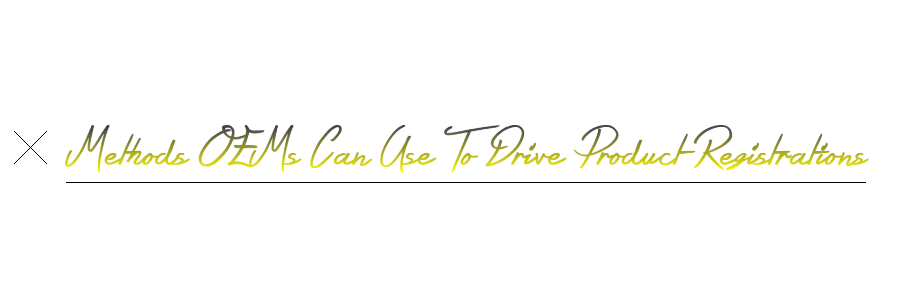Methods OEMs Can Use To Drive Product Registrations
by Black Ink Team

One of the toughest problems for OEMs is how to get more of their end users – homeowners and professionals alike – to register their products with them. The reasons for this are twofold: people generally don’t like giving away their information, and it can be difficult to understand how letting a manufacturer know the serial number of the equipment you just bought benefits you. Manufacturers like having customers fill out product registration forms because it lets them know how to reach them which a) is useful for cross-selling/upselling purposes and b) comes in handy under unfortunate circumstances such as a product recall or property theft.
In addition to learning about their end users, manufacturers can also use product registrations to learn about their individual dealers. Say as a field on a product registration form, a manufacturer put ‘Store Purchased From’ – then they can use that information in aggregate to determine which dealer sold the most, what geographical locations contain the most customers of a certain type, etc. This is called ‘sell-in’ data, as opposed to ‘sell-through’ data which is sales made to end users. Sell-in data becomes obfuscated the second a manufacturer sells their product to a distributor, because they have no way of knowing which of their dealers they eventually sell it to, nor for that matter what end user inevitably ends up buying it.
Analyzing sell-in and sell-through data, i.e. information gleaned from product registrations and KPIs calculated by internal CRMs, can benefit consumer durable goods distribution chains as a whole, but it is hard to align the responsibilities that each link has. One point of contention is whether dealers should handle filling out product registrations, thus ensuring a 100% capture rate, or if end-users should fill them out themselves. A manufacturer should expect to have to offer their dealers something in return, for filling out product registration forms, since doing so and submitting them does not represent an insignificant amount of work. One way to make it easier for dealers would be to partner with distributors as well – having them manage the submission part, for instance, would lighten the load.
If they are going the self-registration route, there are multiple ways in which a manufacturer can increase the likelihood that end-users will fill out product registration forms. One way is they can make it easier for them – by providing a mobile app they can use, or a barcode they can simply scan, to register their product manufacturers can cut the time required for customers to register their product in half or more. (Doing so would also increase the accuracy.) Another way is they can tie ‘clean’ registration forms to benefits such as special discounts, extended warranties, et al.
If they are going the dealer-registration route, manufacturers have several options for incentivizing their dealers to gather as many product registrations as possible. First, they can provide their dealers with insights that they glean from the product registrations themselves. Customer profiles, behavioral patterns, in-depth demographics – much can be learned from product registration data when it is collected to a high degree of accuracy. Secondly, they can reward salespeople for their product registration collection efforts. Partnering with dealers to get the ball rolling when it comes to product registrations can create a self-perpetuating cycle of benefits – more product registrations come in, which lets the manufacturer know more things that will help both them and the dealer.
